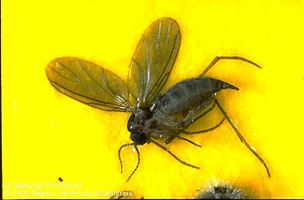|
|
Back to Pest Identification and Diagnosis
 |

|
|
| Fungus Gnat on Yellow Sticky Trap From: University of California |
Life Cycle |
| DESCRIPTION | |
|
Adults: The flies are slender with comparatively long legs and antennae. They are grayish-black and about 2.5 millimeters long.
Eggs: The yellowish-white tiny eggs are 0.2 millimeter long and 0.1 millimeter wide. Larvae: Darkwinged fungus gnat maggots have shiny black head capsules and white bodies. The last body segment is lobed and helps push the insect along. Mature larvae are about 5.5 millimeters long. Pupae: Initially white, pupae become dark shortly before the adult emerges. |
|
| BIOLOGY | |
|
Host Plants: Darkwinged fungus gnat maggots feed on the roots of alfalfa, carnations, clover, corn, cucumbers, Easter lilies, geraniums, lettuce, nasturtium, peppers, rape, poinsettias, potatoes, soybeans, wheat, and organic matter.
Damage: Damage first becomes apparent when plants lose their healthy appearance and wilt. Darkwinged fungus gnat adults are usually noticed before injury caused by the maggots is apparent. Life Cycle: Darkwinged fungus gnat maggots have only recently been recognized as important pests in greenhouses and mushroom cellars. They are also pests of house plants. Several of these flies are of economic concern. Generally, darkwinged fungus gnats are most abundant in greenhouses in the winter and spring. Adults and larvae inhabit moist, shady areas. Adults live about 1week, during which time each female deposits 100 to 150 eggs. They are laid in strings of 3 to 40 in the top of the soil, usually near stems of plants. They hatch within 4 days in the greenhouse. There is a tendency for the progeny of each female to be all one sex. The larvae begin feeding on the root hairs and roots usually in the upper centimeter of medium, working their way up the plant and into the stem; however, they also feed on any organic matter in the soil. Being somewhat gregarious, the larvae often form clusters in the soil. They mature in about 14 days, after which they construct a pupal case, made of silk and debris, in the soil. The pupal stage lasts about 3.5 days. Adults are weak fliers, but they run rapidly on the soil surface or may remain motionless. |
|
| MANAGEMENT STRATEGIES | |
|
Cultural Controls: Clean cultural practices and lack of excessive watering usually will prevent fungus gnat infestations. Since fungus gnats prefer potting mixes containing peat moss and abundant moisture, consider using bark mixes and avoid overwatering ornamental plants. Decoy pots of sprouting grain are attractive to females, that lay eggs in these pots. Afterwards, the pots should be submerged in boiling water or the contents destroyed in some manner every 2 weeks to destroy the eggs and maggots.
Biological Control: Fungus gnats have few efficient natural enemies. The parasitic nematode, Steinernema feltiae, has reduced fungus gnats in mushroom houses 85 percent when applied at a rate of 600 per square meter. Another nematode, Steinernema carpocapsae, is now on the market for fungus gnat control in greenhouses. Pesticides: Some species of fungus gnats in mushroom houses have developed up to 47-fold resistance to pyrethroid insecticides. |
Back to Pest Identification and Diagnosis
 |
(C) Regents of the University of
Minnesota. All rights reserved. |
 |
 |